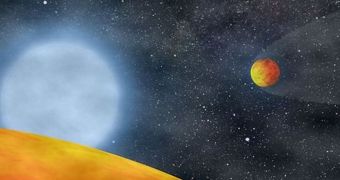In a discovery that raises additional questions about how planets end their lives, scientists have identified the remains of a giant world that was destroyed by intense tidal forces exerted by its parent star. The debris orbits the bloated red giant star KIC 05807616.
But the amount of debris is extremely large. Astronomical observations have identified two planet-sized objects in orbit around this star, each of which is only slightly smaller than Earth. Investigators suggest that both of these chunks belonged to a single, larger extrasolar planet.
According to experts, the larger world may have been destroyed when extreme gravitational pull from its bloating parent star forced it to spiral inward towards the object. Tidal forces would have then shredded it to pieces. Some of them most likely fell into the stars, while other settled on stable orbits.
These discoveries shed some new light on how planets end their lives. Until now, it was believed that most worlds are consumed by their parent stars, destroyed when the latter go supernova, flung out into deep space due to gravitational interactions, or get consumed by newly-formed black holes.
But the new investigation suggests that other fate may await planets as well. Its conclusions indicate that the beginning and end of a world is not always set in stone, a moment that can be clearly marked.
“Planets can still evolve, by disintegrating to several small bodies, or by being completely destroyed,” Israel Institute of technology experts and study authors, Ealeal Bear and Noam Soker, tell Space.
They say that KIC 05807616 was once a yellow dwarf, just like the Sun. As it reached the end of its main sequence, the outer layers of its atmosphere became bloated, expending outward over considerable distances. This will happen in the solar system as well.
According to computer models, the three innermost planets – Mercury, Venus and Earth – will be engulfed within the star. Mars may suffer a similar fate, although it is unclear whether it will be destroyed or not. The other worlds will be left unaffected.
As for the two worlds in orbit around KIC 05807616, they lie very close to their parent star, at only 550,000 miles (900,000 kilometers) and 700,000 miles (1,100,000 kilometers), respectively. They are known as KOI 55.01 and KOI 55.02.
At such a small distance, they are probably tidally locked to their star, meaning that they always keep the same face oriented towards the object. A similar situation can be observed in the relationship between the Moon and Earth.
“We were hoping that other groups would jump on this discovery and propose their own ideas, or refine our interpretations on the subject. We are glad that this happened quite rapidly, as Ealeal Bear and Noam Soker proposed this truly interesting alternative to our scenario,” University of Toulouse expert Stephane Charpinet explains.

 14 DAY TRIAL //
14 DAY TRIAL //